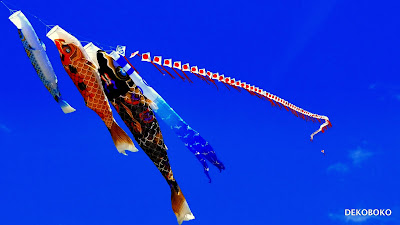
Today is Children's day a national holiday which takes place annually on May 5 and is a part of Golden Week. It is a day set aside to respect children's personalities and to celebrate their happiness and to express gratitude toward mothers. Until recently this holiday was known as Boys' Day, while Girls' Day was celebrated on March 3, and families with children raise the carp-shaped Koinobori flags one for each boy (or child) and display a Kintarō doll and the Kabuto (traditional military helmet) because they are symbols of strong, healthy boys. The koinobori are displayed because they seem to be swimming and are based on a Chinese legend of a carp that swims upstream and because of its strength and hardship transforms into a dragon. Mochi wrapped in kashiwa (oak) leaves and chimaki (sweet rice paste wrapped in iris or bamboo leaf) are traditionally served on this day.











The dragon connection to the carp... do you know if this has been traditional? Interesting. Here is Hawaii, some Japanese families display the carp but I have never seen carp with dragons.
ReplyDeleteI don't know how or when the carp symbol was disseminated to Japan from China and having lived in Hawaii for a number of years I also did not encounter any hints that a dragon connection existed. However, the Chinese dragon, or Lung , symbolizes power, excellence, boldness, heroism, and perseverance - many traits parents would 'traditionally' aspire in their sons. Further, a traditional Chinese folktale involves a carp, who successfully jump rapids and leaps over waterfalls to change into a fish-dragon; which is the source of a still popular saying, "The carp has leaped through the dragon's gate," which means success - especially for students who have passed their exams. Chinese dragon even look a little like carp or have carp-like 'whiskers.' These ideas probably resonated with the Japanese (I would guess during the Sui Dynasty and or Tang Dynasty) who adopted and personalized them.
ReplyDelete